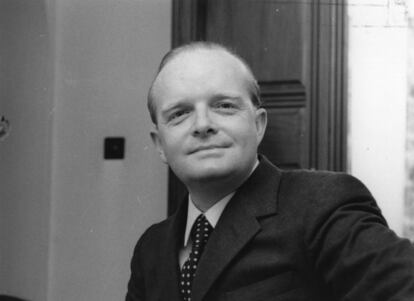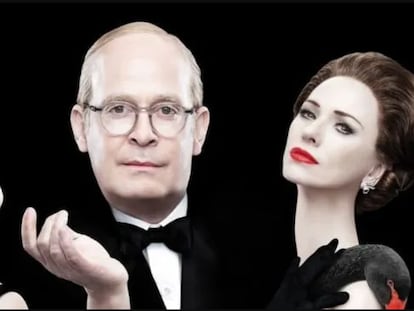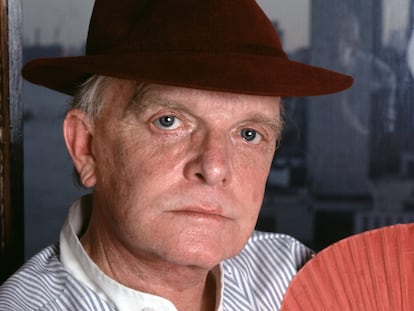Truman Capote, the boy who left home through the front door
The author of ‘In Cold Blood’ made his mark on nonfiction literature and managed to connect with the inexplicable violence that ravages the US, but above all he left behind the myth of a person destroyed by the character. September 30 marks the centenary of his birth


To talk about Truman Capote is to start a multi-dimensional, multi-layered conversation, which includes talking about a horrific crime (the murder of the Clutter family), an inaugural novel (In Cold Blood) and a writer whose personal legend arguably grows even more than his literary consideration. The author, born a century ago in New Orleans, Louisiana, and who died 40 years ago in a very sorry state, left his mark on literature with works such as Breakfast at Tiffany’s, Other Voices, Other Rooms or Answered Prayers, but above all he bequeathed the myth of his audacity and his self-destruction, the yin and yang of creation, magnified by films such as the one starring Philip Seymour Hoffman in 2005, the documentary The Capote Tapes, or the series Feud.
His ambition was his passport. First, to escape the rural and abandoned environment in which he found himself when his mother left him in the care of relatives in Louisiana. Then, in New York, the mecca of a writer and aspiring high society candidate, and to turn his particular style of dress, his flute-like voice, and his open homosexuality into daring distinctive features of his character. Later, to proclaim to the four winds his intention to invent the genre of the nonfiction novel, which he realized with In Cold Blood. And, finally, to air wherever anyone wanted to listen, the creation of a work, Answered Prayers, which he considered would be akin to what Marcel Proust’s In Search of Lost Time had been, and which, on the contrary and in the few chapters he managed to write, was to finish him off. Great challenges that competed on a daily basis with the alcohol and drug addictions that accompanied his talent.
But let’s take it one step at a time. Truman Capote is now firmly established in New York society and in literature after successes such as Breakfast at Tiffany’s, as well as well-received scripts and stories. His intelligent, caustic conversation, his fame and his grace, have made him the guest that everyone wants. He counts writers, celebrities, and artists among his friends. He is the person who changes the course of a party. Pure success and glamor, a guaranteed added value. And that is Truman Capote when, after reading the news published in The New York Times on the morning of November 16, 1959, in a column on its front page (“Rich farmer, three members of his family, murdered”), decides to leave his comfort zone and travel, loaded down with his peculiar wardrobe of an eccentric rich man from New York, to the real, rural and not at all refined America of Holcomb, Kansas.

Capote has chosen to go back to an environment more similar to that of his renegade childhood. And he has chosen a complicated crime. That is to say, when we analyze the murders we find (above all) gender crimes, crimes of revenge, commission, hate, spite, or alienation. Crimes that respond to an attempt at possession and an intention to cause harm. The murder of the Holcomb farmer, his wife, and his children, on the other hand, displays no motive or preconceived plans, but a macabre repetition of horror, room by room, until all the members of a family have been killed and the money the perpetrators were hoping for has not been found. And these are the most difficult crimes to understand and explain. The gratuitous violence deployed by Holcomb’s murderers was the hook for Capote, who decided to sow in his reconstruction the great seed of a genre that was going to change things, at least as far as labeling is concerned.
“By labeling it as a nonfiction novel, Capote inaugurated a genre that in reality already existed in previous books such as Operation Massacre, by Rodolfo Walsh, or Hiroshima, by John Hersey,” says Leila Guerriero, the author of nonfiction works such as her most recent publication, La llamada. “It also generated an ambiguity, because the idea of novel and nonfiction leads to confusion. But there is an enormous achievement in Capote, and that is to have set his eye on a killing, a murder that would not have transcended as, for example, that of the Manson Family in [Roman] Polanski’s house. He chose the story, discovered the tremendous force of how to tell it, and transformed it into something completely universal that speaks of existence and human misery, social classes, gossip, and small-town prejudices. The book marked a path.”
Eduardo Lago, a specialist in American literature, recognizes the impact that In Cold Blood had and believes that it was part of a movement that was developing at that time in the United States. “He did not create it, but rather he joined what other great authors of the so-called New Journalism were doing, from Tom Wolfe to Norman Mailer, Gay Talese and others (no one remembers Joan Didion or Janet Malcolm when talking about this). He was just one more, but In Cold Blood remains a masterful achievement worthy of being reread and celebrated.”
The story is well-known: after travelling to Holcomb and deciding to turn the case into a novel, Capote became obsessed to the point of developing a strange relationship of dependence on one of the murderers, and waiting with a sinister narrative sense for them to be executed to provide an end to the book. That is why it was eventually published in 1966, seven years after the crime, despite the desperation of his editors. Slow-burn journalism. Pure literature. And the rest is legend: his enormous success, but also his anguish, his collapse, his loss of confidence as a writer and his growing addictions, which he unashamedly paraded. As the writer Rodrigo Fresán, a great connoisseur of American literature, says, the character was finally able to become the person in a self-destructive nonfiction of himself, in the same line that F. Scott Fitzgerald, Ernest Hemingway or David Foster Wallace also followed. “[J.D.] Salinger saved himself by disappearing,” he notes.
Lago points to the ultimate reason for this masterful achievement, which is that “he managed to connect with the core of inexplicable violence that has plagued the soul of the United States since its birth as a nation and persists in the continuous collective killings. This is a sick society, as evidenced by the possibility of Trump winning again. Capote captures this scourge in his novel. His protagonists are victims of an inextricable social evil.”

Martín Caparrós, also a prominent nonfiction author, confesses that he never finished In Cold Blood. “It bored me, but I was always impressed by the foundational role attributed to it and which evidences North American cultural hegemony.” The author cites the aforementioned Operation Massacre (1957) or Gabriel García Márquez’s The Story of a Shipwrecked Sailor (1955). “I am not saying that Capote copied them — nor probably knew them — but I am surprised that we continue to attribute to him, along with Mailer, Wolfe and company, the creation of a way of telling stories that had already been marvelously realized in Ñamerica and continued to be so. In short: I believe that Operation Massacre and The Story of a Shipwrecked Sailor influenced our generations of chroniclers much more than In Cold Blood, with apologies. And a pinch of pride.”
Both Fresán and Caparrós consider Music for Chameleons (1980), the final work Capote published during his lifetime, based on loose pieces previously published in Andy Warhol’s Interview magazine, to be his greatest legacy. “It is a kind of artistic-existential summa as well as a writing manual that is much more effective (and economical) than so many literary workshops,” says Fresán. But it was Answered Prayers, the great work of Proustian ambition that he never finished, that finally brought Capote down. Abandoned by the elite that had previously embraced him after he aired their dirty laundry in those few chapters, Capote was left isolated, disconcerted. “He was a predator of his contemporaries,” says Leila Guerriero. And he paid for it. Ultimately turned into a caricature, drunk on the sets and expelled from the high society to which he believed he belonged, Capote was finally found dead in the apartment of a friend in Los Angeles. It was August 25, 1984. He did not live to see 60.
When explaining the strange relationship he developed with the murderer Perry Edward Smith, a young man as unfortunate as he himself had been, Capote said: “It’s as if Perry and I grew up in the same house. And one day he stood up and went out the back door, while I went out the front.” And that house is, without a doubt, literature.
Sign up for our weekly newsletter to get more English-language news coverage from EL PAÍS USA Edition
Tu suscripción se está usando en otro dispositivo
¿Quieres añadir otro usuario a tu suscripción?
Si continúas leyendo en este dispositivo, no se podrá leer en el otro.
FlechaTu suscripción se está usando en otro dispositivo y solo puedes acceder a EL PAÍS desde un dispositivo a la vez.
Si quieres compartir tu cuenta, cambia tu suscripción a la modalidad Premium, así podrás añadir otro usuario. Cada uno accederá con su propia cuenta de email, lo que os permitirá personalizar vuestra experiencia en EL PAÍS.
¿Tienes una suscripción de empresa? Accede aquí para contratar más cuentas.
En el caso de no saber quién está usando tu cuenta, te recomendamos cambiar tu contraseña aquí.
Si decides continuar compartiendo tu cuenta, este mensaje se mostrará en tu dispositivo y en el de la otra persona que está usando tu cuenta de forma indefinida, afectando a tu experiencia de lectura. Puedes consultar aquí los términos y condiciones de la suscripción digital.
More information
Archived In
Últimas noticias
Most viewed
- Sinaloa Cartel war is taking its toll on Los Chapitos
- Oona Chaplin: ‘I told James Cameron that I was living in a treehouse and starting a permaculture project with a friend’
- Reinhard Genzel, Nobel laureate in physics: ‘One-minute videos will never give you the truth’
- Why the price of coffee has skyrocketed: from Brazilian plantations to specialty coffee houses
- Silver prices are going crazy: This is what’s fueling the rally










































